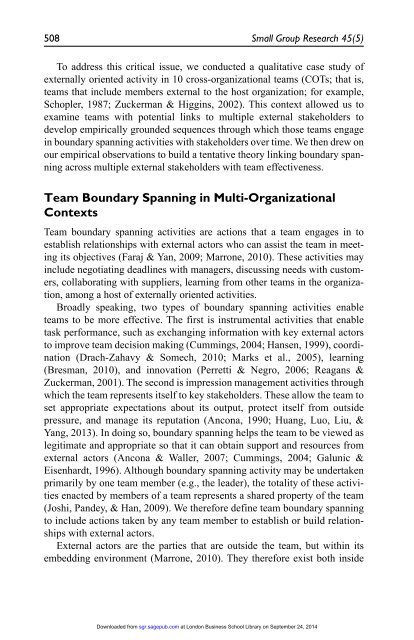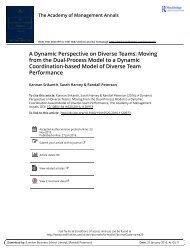The Process of Team Boundary Spanning in Multi-Organizational Contexts - Sarah Harvey, Randall S. Peterson, and N. Anand
Work teams must increasingly operate in complex environments characterized by multiple external actors beyond team and organizational boundaries. Although previous research demonstrates the importance of boundary spanning activities to team effectiveness, it reveals relatively little about the process of boundary spanning in these environments. In this article, we investigated the processes of boundary spanning across multiple external actors in 10 cross-organizational teams. We identified three sequences for reaching out to external actors: (a) moving inside-out from vertical actors inside the host organization to horizontal actors outside of the host organization, (b) moving outside-in from horizontal actors to vertical, and (c) staying-inside with vertical actors from the host organization. Our observations suggest that inside-out and outside-in sequences were more successful than simply pleasing the host organization. We build on our empirical findings to develop a process theory of how team boundary spanning activities across multiple external actors influence team effectiveness. Our research underscores the importance of a team’s interactions with actors in its external environment beyond those in an immediate supervisory role and provides insight into the dynamics of boundary spanning in multi-organizational contexts.
Work teams must increasingly operate in complex environments
characterized by multiple external actors beyond team and organizational
boundaries. Although previous research demonstrates the importance of
boundary spanning activities to team effectiveness, it reveals relatively little
about the process of boundary spanning in these environments. In this article,
we investigated the processes of boundary spanning across multiple external
actors in 10 cross-organizational teams. We identified three sequences for
reaching out to external actors: (a) moving inside-out from vertical actors inside
the host organization to horizontal actors outside of the host organization,
(b) moving outside-in from horizontal actors to vertical, and (c) staying-inside
with vertical actors from the host organization. Our observations suggest
that inside-out and outside-in sequences were more successful than simply
pleasing the host organization. We build on our empirical findings to develop
a process theory of how team boundary spanning activities across multiple
external actors influence team effectiveness. Our research underscores the
importance of a team’s interactions with actors in its external environment beyond those in an immediate supervisory role and provides insight into the
dynamics of boundary spanning in multi-organizational contexts.
Create successful ePaper yourself
Turn your PDF publications into a flip-book with our unique Google optimized e-Paper software.
508 Small Group Research 45(5)<br />
To address this critical issue, we conducted a qualitative case study <strong>of</strong><br />
externally oriented activity <strong>in</strong> 10 cross-organizational teams (COTs; that is,<br />
teams that <strong>in</strong>clude members external to the host organization; for example,<br />
Schopler, 1987; Zuckerman & Higg<strong>in</strong>s, 2002). This context allowed us to<br />
exam<strong>in</strong>e teams with potential l<strong>in</strong>ks to multiple external stakeholders to<br />
develop empirically grounded sequences through which those teams engage<br />
<strong>in</strong> boundary spann<strong>in</strong>g activities with stakeholders over time. We then drew on<br />
our empirical observations to build a tentative theory l<strong>in</strong>k<strong>in</strong>g boundary spann<strong>in</strong>g<br />
across multiple external stakeholders with team effectiveness.<br />
<strong>Team</strong> <strong>Boundary</strong> <strong>Spann<strong>in</strong>g</strong> <strong>in</strong> <strong>Multi</strong>-<strong>Organizational</strong><br />
<strong>Contexts</strong><br />
<strong>Team</strong> boundary spann<strong>in</strong>g activities are actions that a team engages <strong>in</strong> to<br />
establish relationships with external actors who can assist the team <strong>in</strong> meet<strong>in</strong>g<br />
its objectives (Faraj & Yan, 2009; Marrone, 2010). <strong>The</strong>se activities may<br />
<strong>in</strong>clude negotiat<strong>in</strong>g deadl<strong>in</strong>es with managers, discuss<strong>in</strong>g needs with customers,<br />
collaborat<strong>in</strong>g with suppliers, learn<strong>in</strong>g from other teams <strong>in</strong> the organization,<br />
among a host <strong>of</strong> externally oriented activities.<br />
Broadly speak<strong>in</strong>g, two types <strong>of</strong> boundary spann<strong>in</strong>g activities enable<br />
teams to be more effective. <strong>The</strong> first is <strong>in</strong>strumental activities that enable<br />
task performance, such as exchang<strong>in</strong>g <strong>in</strong>formation with key external actors<br />
to improve team decision mak<strong>in</strong>g (Cumm<strong>in</strong>gs, 2004; Hansen, 1999), coord<strong>in</strong>ation<br />
(Drach-Zahavy & Somech, 2010; Marks et al., 2005), learn<strong>in</strong>g<br />
(Bresman, 2010), <strong>and</strong> <strong>in</strong>novation (Perretti & Negro, 2006; Reagans &<br />
Zuckerman, 2001). <strong>The</strong> second is impression management activities through<br />
which the team represents itself to key stakeholders. <strong>The</strong>se allow the team to<br />
set appropriate expectations about its output, protect itself from outside<br />
pressure, <strong>and</strong> manage its reputation (Ancona, 1990; Huang, Luo, Liu, &<br />
Yang, 2013). In do<strong>in</strong>g so, boundary spann<strong>in</strong>g helps the team to be viewed as<br />
legitimate <strong>and</strong> appropriate so that it can obta<strong>in</strong> support <strong>and</strong> resources from<br />
external actors (Ancona & Waller, 2007; Cumm<strong>in</strong>gs, 2004; Galunic &<br />
Eisenhardt, 1996). Although boundary spann<strong>in</strong>g activity may be undertaken<br />
primarily by one team member (e.g., the leader), the totality <strong>of</strong> these activities<br />
enacted by members <strong>of</strong> a team represents a shared property <strong>of</strong> the team<br />
(Joshi, P<strong>and</strong>ey, & Han, 2009). We therefore def<strong>in</strong>e team boundary spann<strong>in</strong>g<br />
to <strong>in</strong>clude actions taken by any team member to establish or build relationships<br />
with external actors.<br />
External actors are the parties that are outside the team, but with<strong>in</strong> its<br />
embedd<strong>in</strong>g environment (Marrone, 2010). <strong>The</strong>y therefore exist both <strong>in</strong>side<br />
Downloaded from sgr.sagepub.com at London Bus<strong>in</strong>ess School Library on September 24, 2014
















